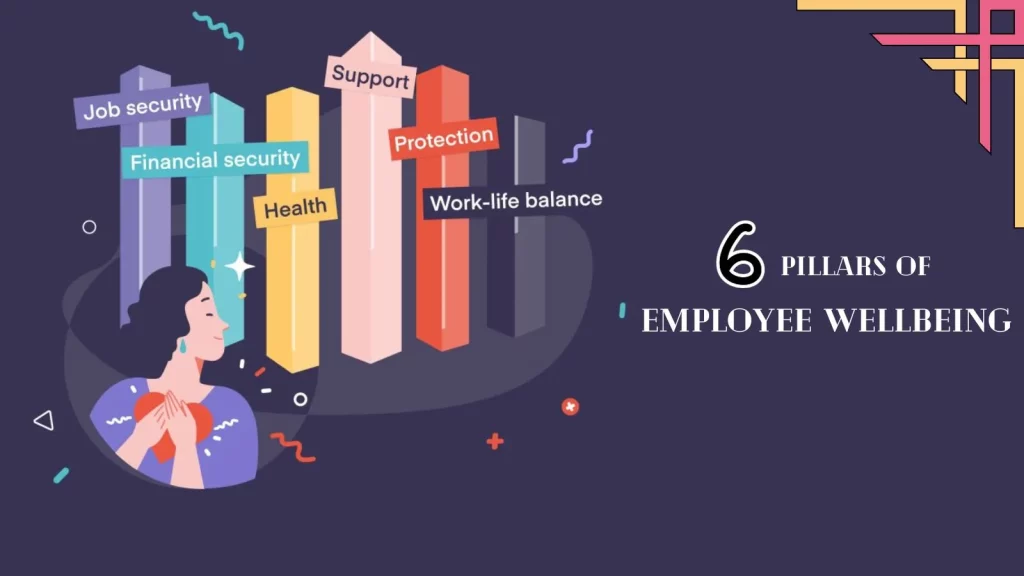Crafting a solid employee wellbeing strategy goes beyond physical health- it’s about fostering a workplace where employees thrive.
This guide explores key elements to build a plan that nurtures employees’ wellbeing. From understanding their needs to creating a supportive environment, discover actionable steps to enhance morale, productivity, and satisfaction.
Join us on this journey to unlock the essentials of a robust employee wellbeing strategy that empowers your workforce and drives success.
LISTEN TO THE PODCAST NOW!
Why You Need To Focus On Employee Wellbeing Now
Focusing on employee wellbeing today is crucial as it directly impacts organizational success and employee satisfaction. In this dynamic work environment, prioritizing wellbeing isn’t just a trend; it’s a strategic necessity.
Addressing employee wellbeing fosters a positive workplace culture, enhances productivity, and aids in- talent retention. Moreover, amidst evolving work models and increased stress, supporting employee wellbeing is paramount to- prevent burnout, boost morale, and maintain a motivated workforce.
By focusing on employee wellbeing now, organizations can cultivate a strong, engaged, and high-performing team that drives success in the long run.
What Are The 6 Pillars Of Employee Wellbeing?
Employee wellbeing encompasses multiple dimensions that contribute to an individual’s overall health and happiness. The six pillars of employee wellbeing form a comprehensive framework that addresses various aspects of an employee’s life, both at work and beyond.
Physical Wellbeing: This pillar focuses on promoting a healthy lifestyle. It involves initiatives such as fitness programs, access to nutritious food, encouraging regular exercise, and providing a conducive environment for adequate rest and improvement. Organizations may offer gym facilities, wellness workshops, or comfortable workstations to support physical health.
Mental Wellbeing: Mental health support has gained importance in recent years. This pillar involves creating a work environment that reduces stress, fosters resilience, and encourages open conversations about mental health. Offering counseling services, stress management workshops, and mindfulness programs are effective strategies.
Emotional Wellbeing: Emotional wellbeing emphasizes self-awareness, empathy, and fostering positive relationships. It involves employee wellbeing initiatives that encourage- emotional intelligence, team-building exercises, conflict resolution strategies, and creating a supportive workplace culture where individuals feel understood and valued.
Social Wellbeing: Building strong social connections and a sense of community at work is essential. This pillar involves promoting teamwork, collaboration, and inclusivity. Organizing social events, team-building activities, and mentorship programs enhances social connections and a feeling of belonging among employees.
Financial Wellbeing: Financial security and stability greatly impact overall wellbeing. Employers can support this pillar by offering financial planning workshops, retirement benefits, or access to resources that aid in managing personal finances, reducing financial stress among- employees.
Career Wellbeing: This pillar revolves around job satisfaction, opportunities for growth, and skill development. Providing career development programs, regular feedback sessions, and opportunities for advancement contribute to employees’ sense of purpose and satisfaction in their roles.
By addressing these six pillars, organizations can create a comprehensive employee wellbeing strategy that supports individuals in leading healthier, more fulfilling lives, both professionally and personally.
Why To Create An Employee Wellbeing Strategy?
Creating an employee wellbeing strategy is essential for several reasons:
Enhanced Performance: Wellbeing strategies boost employee morale, motivation, and employee engagement, leading to increased- productivity and performance.
Talent Retention: Prioritizing employee wellbeing fosters loyalty and reduces turnover rates, attracting and retaining top talent.
Positive Work Environment: It cultivates a supportive workplace culture, fostering a positive atmosphere and strong employee relationships.
Health and Safety: Wellbeing strategies promote physical and mental health of employees, reducing absenteeism due to illness and stress-related issues.
Improved Reputation: Companies known for prioritizing- employee wellbeing attract positive attention, benefiting their reputation and brand image.
Cost Savings: Investing in wellbeing initiatives can reduce healthcare costs, absenteeism, and turnover, resulting in long-term financial benefits.
Ultimately, an employee wellbeing strategy isn’t just about being socially responsible—it’s a strategic decision that significantly impacts the organization’s success, employee satisfaction, and overall workplace culture.
Tips To Improve Your Employee Wellbeing Strategy
Crafting an effective employee wellbeing strategy demands a comprehensive approach that prioritizes various dimensions of an individual’s health and happiness- within the workplace. Here are tips to increase productivity in the workplace:
Integrated Wellbeing:
Recognize that wellbeing extends beyond physical health. Embrace a holistic perspective that encompasses- mental, emotional, social, and even financial aspects. Tailor initiatives to serve these diverse needs, including fitness programs, mental health resources, stress management sessions, and social engagement activities.
Engagement and Communication:
Foster open communication channels that encourage dialogue and active participation. Involve employees in decision-making processes regarding wellbeing initiatives, valuing their insights and feedback. Actively listen to their needs and concerns, building a sense of belonging and ownership within the organization.
Flexible Work Arrangements:
Support work-life balance by offering flexible work arrangements or remote options. Adapt the work environment to accommodate diverse lifestyles, enabling employees to- effectively manage personal responsibilities alongside professional commitments.
Leveraging technology for wellbeing:
Integrate EmpMonitor, the employee monitoring software to gain valuable insights into employee productivity. Analyze work patterns to identify trouble or excessive workloads. Utilize this data to implement necessary support systems and ensure a balanced work environment, ultimately fostering improved employee wellbeing.
EmpMonitor: Employee Performance Monitoring
EmpMonitor is a software designed for comprehensive employee performance monitoring. It provides insights into employee productivity, task management, and time tracking, aiding organizations in understanding work patterns and optimizing efficiency. This tool enables businesses to analyze employee engagement and wellbeing, identify potential areas of improvement, and maintain a productive work environment.
EmpMonitor offers a range of features:
Time Tracking: Monitors and records time spent on tasks and projects, helping in assessing productivity and work allocation.
Productivity Analysis: Provides insights into employee activities, websites visited, applications used, and overall productivity levels.
Real-time Monitoring: Allows live tracking of employee activities, enabling immediate intervention or guidance if necessary.
Screenshots and Keystroke Logging: Captures screenshots or keystrokes to understand work patterns and task progress.
Remote Work Monitoring: Enables monitoring of remote employees, ensuring accountability and productivity even in remote settings.
Reports and Analytics: Generates comprehensive reports and analytics on employee performance and work patterns for informed decision-making.
Security Features: Ensures data security and privacy compliance, safeguarding sensitive information.
These features collectively empower organizations to effectively monitor employee wellbeing and performance, optimize workflows, and maintain a productive work environment, whether in-office or remote settings.
Comprehensive Wellness Programs:
Develop a range of wellness initiatives that serve varied needs. Offer a range of programs covering physical health, mental wellbeing, stress reduction, nutrition guidance, mindfulness practices, and workshops on resilience.
Support Systems:
Provide robust support systems encompassing counseling services, support groups, or employee assistance programs. Ensure individuals facing personal or professional challenges have access to resources that help them navigate and overcome obstacles.
Regular Evaluation and Adaptation:
Continuously assess the effectiveness of your wellbeing strategy. Utilize feedback mechanisms, conduct surveys, and analyze relevant metrics. Adapt and refine the strategy based on evolving needs, trends, and the feedback received from- employees.
Implementing these key points not only fosters a culture of wellbeing but also cultivates a supportive and empowering environment. An effective wellbeing strategy contributes to higher job satisfaction, enhanced performance, reduced turnover rates, and a more resilient workforce.
By investing in employee wellbeing and incorporating tools like EmpMonitor for insights into productivity and stress levels, organizations cover the way for a healthier, happier, and more engaged workforce, ultimately driving long-term success and growth.
ALSO READ
08 Tips To Improve Productivity In The Workplace
Employee Engagement Solutions For 2023: An Hr Leader’s Guide
7 Employee Wellbeing Strategy For Better Workspace In 2024
What Is Gaslighting At Work: How To Effectively Deal With It
How To Engage Employees In Wellbeing Strategy
Engaging employees in a wellbeing strategy involves strategic steps that resonate with their needs and preferences.
Build a brand for your wellbeing program.
Create a distinct brand identity for your wellbeing initiative. Utilize marketing resources to promote the program within the organization. Ensure the messaging is compelling, appealing, and eye-catching to capture employee interest and engagement.
Create an effective schedule for wellbeing activities.
Plan the implementation of wellbeing activities across the company systematically. Consider staffing levels, work schedules, and employee availability when scheduling these- initiatives. This approach ensures maximum participation and involvement.
Reflect national trends in your wellbeing initiatives
Integrate national trends and observances into your wellbeing strategy. Utilize significant events such as World Mental Health Day or Time to Talk Day to introduce specialized mental health courses or initiate open discussions about mental wellbeing. Linking your initiatives to these broader trends enhances relevance and participation.
Seek feedback from employees on their wellbeing experience.
Establish a robust feedback system to gather employee insights on their wellbeing experiences. Use surveys, anonymous forums, or dedicated focus groups to collect feedback consistently. Analyze this feedback to gauge the- effectiveness of the strategy and make necessary adjustments in real time.
By establishing a compelling brand, strategically scheduling activities, aligning with broader trends, maintaining a feedback loop, and fostering employee involvement, organizations can effectively engage their workforce in a- wellbeing strategy. This approach not only encourages participation but also ensures that the strategy evolves in tandem with the dynamic needs of the employees, fostering a healthier and more engaged workforce.
Conclusion
Crafting an effective employee wellbeing strategy isn’t merely a trend; it’s a fundamental pillar of a successful workplace. By prioritizing the mental, physical, and emotional health of your employees, you’re nurturing a culture of support and productivity.
A comprehensive strategy involves more than just perks—it’s about creating an environment where individuals feel valued and cared for. Initiatives like flexible work hours, mental health resources, fitness programs, and supportive leadership play pivotal roles in this framework.
Integrating advanced tools like EmpMonitor, which enables a balanced approach to workload and offers insights into employee productivity while respecting their privacy, can aid in managing work stress and fostering a healthier work-life balance.
When employees feel their wellbeing matters, they’re more engaged, resilient, and motivated. It translates directly into improved productivity, reduced turnover, and a positive company reputation. It’s not merely a box to tick but a commitment to the overall growth of your workforce.
Remember, the success of an effective wellbeing strategy isn’t immediate; it evolves with consistent efforts and adjustments. Ultimately, a workplace that prioritizes employee wellbeing doesn’t just benefit its staff—it brings rewards in overall performance and success.














